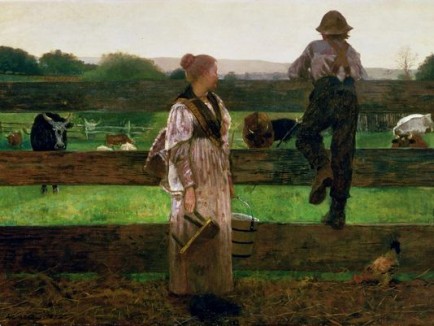Today’s sad sale at Christie’s in London, where Isabella and the Pot of Basil, which was being deaccessioned by the Delaware Art Museum, failed to raise much money — just $4.24 on the hammer, versus a low estimate of $8.4 million (and we don’t know if Christie’s waived the commission or not) — begs another look at the situation there.
 Just last week, no less an authority than Timothy Rub, director of the Philadelphia Art Museum, writing against the deaccessions in the Wall Street Journal, wrote: Â “Given its importance, the work may fetch much more than that.” I’m not blaming him for optimism — no one can predict markets — but I do believe the Delaware museum trustees had been thinking the same way. Now, trustees may have difficulty raising $30 million, their goal, by selling just four works.
Just last week, no less an authority than Timothy Rub, director of the Philadelphia Art Museum, writing against the deaccessions in the Wall Street Journal, wrote: Â “Given its importance, the work may fetch much more than that.” I’m not blaming him for optimism — no one can predict markets — but I do believe the Delaware museum trustees had been thinking the same way. Now, trustees may have difficulty raising $30 million, their goal, by selling just four works.
Rub’s larger point was about those very trustees: “It is important to recognize that the key to this issue is good governance.” What he left unsaid is that trustees made the fundamental mistake several years ago, when they expanded the museum.
In comments to Rub’s article, Gail O’Donnell, a former museum official made a few but damning points, including:
- The Wilmington population is 80,000, a smaller market than those of the institutions criticizing the Delaware Art Museum.
- The museum’s “hard to sell” building, unlike the Folk Art Museum in New York, is in a residential neighborhood and could not be sold.
- The museum’s donor pool is limited.
But why weren’t those trustees thinking about those items when the museum expanded, which caused the debt the museum is now struggling to pay? To quote from the museum’s website:
On June 26, 2005, the Museum reopened with extensive renovations to the original 1938 building and three new Museum wings, offering new facilities for the permanent collection and special exhibitions, arts education programs, the Thronson Café, the Museum Store, offices, meeting areas, and collections care facilities. Total facilities now include over 80,000 square feet of space.
In hindsight, one has to ask:Â Why did Delaware, with such a small population, feel the need to expand?
 Museums have been on an expansion jag since at least the mid-90s, almost unrelentingly. Even during the recessions, expansions continued, and Delaware was far from alone. But it’s sad that they seemed to value that bigger, fancier building more than what it is in it — because that’s what it looks like now.
Museums have been on an expansion jag since at least the mid-90s, almost unrelentingly. Even during the recessions, expansions continued, and Delaware was far from alone. But it’s sad that they seemed to value that bigger, fancier building more than what it is in it — because that’s what it looks like now.
To show how high tensions have risen, O’Donnell made an astonishing, low-blow accusation at the end of her comment:
…were the museum to close and dissolve its collections, the very institutions that might benefit, acquiring works at fire-sale prices, are those that are active in their condemnation of this action.
I really highly doubt that the Philadelphia Museum would grab at Delaware’s collection.
Now, it seems, Homer’s Milking Time and Calder’s Black Crescent, are next to go.
Photo Credits: Courtesy of the Delaware Art Museum
